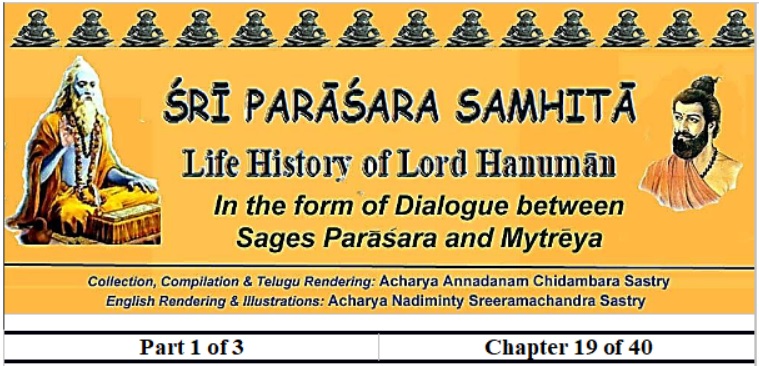
19th Chapter (ĒkōnavimśatiPaţalah)
“Narration of the Six Exclamations and Others”
(Śatpallavādivivaraņamm)

श्रीमैत्रये :
षट्पल्ल्वप्रकारस्तु षट्प्रयोगस्तु कीदृश:?
के वा स्त्रीमंत्रपुंमंत्र क्लीबमंत्रा: स्मृता: मुने!।। 1
Mytrēya
“Oh! Great sage Parāśara! What is the method of using the şaţpallava (the worship ritual related Six Exclamations) and şaţprayōga (Six Worship Related Activities) like? Which ones are described as masculine mantras, which – as feminine mantras and which – as neutral gender mantras? (1)
हनुमन्मंत्रसंख्याका चक्राणां च विशेषत:
भक्ति: कतिविधा ज्ञेया कथं जप्यं हि सूतके।। 2
How many are the Hanumanmantras? How many are the types Hanumān devotion? How one has to perform acts for or getting rid of the sootaka (imputity related to birth etc)? (2)
सोमसूर्योपरागे च पुरश्चर्या कथं भवेत्?
मन्त्रश्च को र्वणं प्रोक्तमविरोधी च किं पुन:? 3
How the repetitive routines have to be carried out during lunar and solar eclipse? How is (that) mantra? What is method of following that mantra without restraint? (3)
हनूमन्मन्त्रजालस्य विरुद्धं वा किमुच्यते
एतत्संगृह्वा वक्तव्यं कृपया मुनिसत्तम!।। 4
What is told as contrary to the whole set of Hanumanmantras? Oh! Best of Sages! Kindly enlighten me on all this”. (4)
श्रीपराशर :
षट्पल्लवादिकं पृष्टं भवता मुनिसत्तम!
अधुना तत्प्रवक्ष्यामि क्रमेणैव विभाव्यताम्।। 5
Parāśara
(Always sperform under the guidance of a Guru)
Şaţpallava & Şaţprayōga
“Oh! Best of sages! The worship ritual related ‘Six Exclamations’ (şaţpallava) and other issues were asked by you. I am narrating them in order. May be imbibed (by you). (5)
पल्लवाश्च प्रयागाश्च बहवस्सन्ति वै मुने!
नमो वषट् च खेखे च हुं वौषट् च फडित्यपि।। 6
Oh! Mytrēya! There are many worship related ‘Exclamations’ and ‘Activities’. ‘Namah’ (reverent bow), ‘vaşat’, ‘khēkhē’, ‘humm’, ‘vauşat’ and ‘phat; (calls / exclamations to Fire and other Gods to accept offerings) are (6)
एते षट्पल्लवा: प्रोक्ता: षट्प्रयोगे फलं त्रूणु।। 7
The worship ritual related ‘Six Exclamations’ (şaţpallava). Now I will tell the şaţprayōga (Six Worship Related Activities) and its utility. Listen. (7)
नमस्संपद्वषड्वश्ये वौषडाकर्षणे तथा
हुं द्वेषे च फडूच्चाटे खेखे च मारणे विदु:
स्वाहा पुष्टिकरं चेति पल्लवाग्रे निगद्यते।। 8
Use of the word ‘Namah’ for wealth, ‘vaşat’ for subjugation, ‘vauşat’ for attraction, ‘humm’ for dislike, ‘phat’ for destruction and ‘khēkhē’ for seeking death is known. The word ‘swāhā’ is said to be life supporting. (8)
शांतिरुच्चाटनं द्वेष: स्तंभनं मारणं तथा
वश्यं चावश्यमीषच्च षट्प्रयोगा उदाह्रता:।। 9
The Six Activities (şaţprayōga) are said to be ‘śānti (peace), ‘uccātana’ (eradication / ending) ‘dwēşa‘ (intense dislike), ‘sthambhana’ (stoppage), ‘māraņa‘ (taking life), and ‘vaśya’ (taking under control). (9)
तत्तत्पल्लवसत्वे पि वर्णसंज्ञां न पूरयेत्
उचितं षट्प्रयोगानां पुन: पल्लवमुच्यते
पुन: पल्लवसंयोगे प्रत्यवायो न विद्यते।। 10
Even if any Exclamation (pallava) exists no indication of it should be made with any ‘letter’ (akşara). Performing the ‘Six Exclamations’ (şaţpallava) is proper for the Six Activities (şaţprayōga). Repeating the Six Exclamations (şaţpallava) will give no contrary result. (10)
स्त्रीमंत्रस्तु नमोन्तस्स्यात्स्वाहांत: पुरुषस्तथा
क्लीवस्तु वषडंतस्स्यात् स्त्रीक्लीवाश्च अमी स्मृता:।। 11
Genders of Mantras
It is told that feminine (stree) mantras end with the word ‘namah’, masculine (puruşa) mantras end with ‘swāhā’, while the neutral gender (napumsaka) mantras end with vaşat. These are considered to be variants of the feminine word. (11)
स्त्रीमंत्रश्शीघ्रफलद: आलस्यं पुरुषस्य च
क्लीवो महाविलंबश्च एतेषां फलमीरितम्।। 12
While the streemantras are said to give quick results, the puruşamantras take time; the napumsakamantras take a lot of time to become fruitfull. The fruits of these are also described. (12)
कत्यांजनेयमनव: इति वक्ष्यामि ते त्रूणु
सुवर्चलासमेतश्रीहनुमद्वादशाक्षरीम्।। 13
Number of Mantras
You asked, how many are the Hanumanmantras. I am answering that question. Listen. The Suvarchalā samēta Śri Hanumatdwādaśākşrī (mantra) (13)
सव्यंजने व्यंजनेषु व्युत्क्रमश्च क्रमो पि च
महर्षयो मंत्रसिद्धा: एतद्रूपजपान्मुने।। 14
Mytrēya! Has been followed by mantra-endowed great sages (ŗşis) wit the vowels, with consonants, in alphabetical order (Sanskrit) and even without any particular order. (14)
शंभुना चोपदिष्टं तत्पार्वत्यै हितकाम्यया
खिलसंयुतया चैवं प्रत्यपादि मनुर्मुने।। 15
Oh! Mytrēya! Great sage! Desirous of benefit to the world, Lord Śankara told Goddess Pārvatī the mantras along with supplementaries. (15)
अथैषा विविधा प्रोक्ता केवलद्वादशाक्षरी
अष्टाक्षरी कपीन्द्रस्य पंचधा परिकीर्तिता
पंचाक्षरी तु तस्यैव त्रिविधा परिकीर्तिता।। 16
Now this dwādaśākşrī mantra alone is told to be of many varieties. Hanumataśţākşarī (8-lettered) mantra is renowned to be in five varieties. Lord Hanumān’s pañcākşarī (5-letterd) mantra is repected in three varieties. (16)
एकाक्षरी महामंत्रो द्विविधा परिकीर्तिता
षडक्षरी चतुर्धातु कीर्तिता हनुमत्प्रभो: ।। 17
Lord Hanumān’s mālāmantras (chain-mantras) are said to be twenty five. The great ēkākşarī mantra (one-lettered) is respected to be of two types. Lord Hanumān’s 6-lettered şadākşarī mantra is well known to be of four varieties. (17)
आरभ्यैकाक्षरीमंत्रं वायुसूनोर्महात्मन:
द्वात्रिंशद्वर्णपर्यन्ता: मन्त्रास्तु सुव्यवस्थिता:।। 18
Lord Hanumān’smantras are explained from the one-lettered (ekākşarī) to 32-lettered (dwātrinśadvarņa) mantras. (18)
सप्तमंत्रात्मिकाविद्या पव्म्चवक्त्रहनूमत:
सप्तविंशतिमंत्रैश्च विद्या तस्यैव धीमत:
शौनकीसंहितायां तु सम्यगेव व्यवस्थिता।। 19
Then there is the five-faced Pañcamukha Hanumān’s seven mantras group of (sapta mantrātmalā vidya) is also there. (19)
शाबरा अपि मन्त्राश्च बहव: कथिता: कपे
हनुमन्मंत्रजालानि शतपव्म्चकसंख्यया।।
इतिहासपुराणेषु कथितानि महामुने।। 20
Many more colloquial (quick-fix!) śabara mantras of the forest dwellers are described. Five hundred Hanumān mantras are described in itihāsas and purāņas (historical works and scriptures). (20)
पुरश्र्चर्यामपेक्षंते महामंत्रास्तु सर्वश:
शाबराणां तु मंत्राणां तदपेक्षा न विद्यते।। 21
Repetitive routines (puraścarya vidhāna) are a must for the great mantras; while no such routine is required for the śabaramantras of the forest dwellers. (21)
गुरूपदिष्टमंत्रेण यथाशक्ति जपेत्सुधी:।। 22
For the śabara mantras of the forest dwellers, the only duty is reciting them as best as they can following the Guru’s instructions, (22)
मंत्राणां समसंख्यानि चक्राण्यपि हनूमत:।। 23
The amulet using systems are as many as there are the Hanumanmantras.. (23)
भक्तिर्बहुविधा प्रोक्ता तथा नवविधा स्मृता
श्रवणं कीर्तनं विष्णो: स्मरणं पादसेवनम्
अर्चनं वन्दनं दास्यं सख्यनात्मनिवेदनम्।। 24
Devotion Methods
Devotion towards the Lord is said to be of several ways – śravaņam (listening), kīrtanam (singing praises), smaraņam (thinking again and again), pādasēvanam (service at the feet), arcanam (expression of reverence), vandanam (respectful folding of hands with bowed head), dasyam (surrender), sakhyam (friendship), ātmanivēdanam (seeking asylum) are the nine ways. (24)
उपदिष्टानि मंत्राणि मृतजातकसूतके
जपे स्थित्वा हि मौनेन जपेदेव न संशय:।। 25
During impurity periods related birth are death (mŗta jātaka sūtakē) in the family, and can sit for recitation and recite silently. (25)
अज्ञानाद्यदि वा लोभात् मंत्रत्यागे दरिद्रता
सोमसूर्योपरागेषु जपेन्मंत्रमतंद्रित:।। 26
Destitution sets in if recitation of the mantra is stopped due to innocence or miserliness. One has to recite the mantra calmly during lunar and solar eclipses. (26)
ग्रस्यमाने भवेत्स्नानं ग्रस्ते होमो विधीयते
मुच्चमाने भवेद्ध्यानं मुक्ते स्नानं विधीयते।। 27
One has to take bath as the eclipse sets on, perform hōma when it is set and on, and meditate as it sets off. One has to take bath again after the eclipse is over. (27)
मुच्यमाने वदेन्मंत्रं जपेदेवोपरागके
पुरश्चर्याविधानेन यथोक्तं फलमाप्नुयात्।। 28
As the eclipse ends the mantra has to be recited. During eclipse period one has to continue reciting (silently). Such a system of worship during the eclipse is beneficial. (28)
कुर्यादेवावकाशे तु तथा होमं च तर्पणम्
नास्ति चेदवकाशस्तु परेद्युर्होमतर्पणे।। 29
If possible, perform libation sacrifice (tarpaņahōma) then itself; if not the, the next day. (29)
अर्वणं ते प्रवक्ष्यामि मंत्राण्रामितरेतरम्।। 30
Oh! Mytrēya! I am telling the performance procedure of mantras. Listen. (30)
स्वप्नदत्ते स्त्रिया दत्ते मालामंत्रे थ बीजके
श्रीविद्यासिद्धविद्याभ्यां सिद्धारीन्नैव शोधयेत्।। 31
There is no particular need for argument (vivēcana) regarding the perfection (siddha) and counter positions (aristān) for mantra given in dream, mantra given by a lady (streedatta), chain or mālāmantras, seed (beeja) mantras, streevidya (women knowledge) and siddhavidya (attainment knowledge). (31)
स्त्रीदत्तं स्वप्नलब्धं वा भाषामन्त्रं त्वशाबरं
प्रणवं वैदिकं चैव अरिमित्रं न शोधयेत्।। 32
There is no need for discussion of pros and cons (vivēcana) of perfection (siddha) and counter positions (aristān) for swapna (dream), streedatta, labdha (acquired), bhāşa (language) mantras that are not forest dwellers’, Ōmkāra (Ōmm) and Vēda based mantras. (32)
प्रणव×यक्षरी भूयाद्वथोमभावा षडक्षरी
प्रसादा बहुरूपी च सर्वसाधारणी स्मृता।। 33
Most commonly recited mantras are – praņava (Ōmm), tryakşarī (3-lettered), şadakşarī (6-lettered). (33)
ततो तिरिक्तयन्त्राणां शोधयेदात्मनो र्वणम्।। 34
For all the other mantras, the performance method is as it suits the performer. (34)
जननं जीवनं चैव ताडनं बोधनं स्मृतम्
अथाभिषेको विमलीकरणा प्यायिनी पुन:
तर्पणं दीपनं गुप्ति: दशैता मंत्रसत्क्रिया:।। 35
Mantra samskāra
The essential rites for mantras (mantra samskāra) are the following ten – mantrōtpatti (birth of the mantra), mantrajīvana (life of the mantra), tādanakriya (‘beating’ to perfection), bōdhana (teaching), mantrābhişēka (be sprinkled with mantra), vimalīkaraņa (purification), āpyāyana (making full), tarpaņa (presenting water libation), dīpana (invigoration), and mantragōpana (concealment of mantra). (35)
चिंतामणिं कार्तवीर्यं नामत्रयं सुदर्शनम्
आंजनेयं हयग्रीवं राममन्त्रं न शोधयेत्।। 36
There is no need for examining the procedures of the mantra of the Thought Diamond (cintāmaņi), mantras of the Kārtavīrya, of the three Sudarśna named (kings), Āñjanēya, Hayagīiva and Rāma. (they are elite mantras). (36)
सुदर्शनो वराहश्च नारसिंहस्तथैव च
श्रीमदष्टाक्षरी चैव चत्वारो मन्त्रसत्तमा:।। 37
Known as best of mantras (mantraśrēşţha) are the Sudarśana (disc weapon of Vişņu) mantra, Varāhamantra (boar incarnation of Vişņu) mantra, Nārasimhamantra (man-lion incarnation of Vişņu) mantra, Śrīmadşţaksarī (revered 8-lettered) mantra. (37)
सुदर्शनो विशेषेण चतुर्णां शीघ्रसिद्धिद:
सर्वेषां मन्त्रजालानां वाग्भवं भुवनेश्वरम्
महालक्ष्मीं पुरस्कृत्य जपेत्सर्वार्थसिद्धये।। 38
Sudarśana mantra gives fruit fast. Out of all the mantras the Śrī Bhuvanēśwarī (Revered Ruler of the World) mantra with the Speech-oriented Seed (vāgbhavabījasamyuta) is recited, preceded by Lakşmībeeja (Wealth Seed!) for all attainments / fruits (sarvasiddhi). (38)
तारादिं वासरादिं वा यदि वा·प्यथवापि वा
वाडयादिकमन्त्राणां जप: प्रोक्तश्च दोषह्रत्।। 39
Language-based (bhāsarūpa) mantras can be practiced even without considering the appropriateness of star positions, days and others; there is no mistake in this. (39)
प्रसादं प्रवणं लक्ष्मीं अष्टार्णं द्वादशाक्षरी
गोपालं वामनं विष्णुं मित्रारीन्नैव शोधयेत्।। 40
For auspiciousness-bestowing type mantras like praņava, Lakşhmī, aştākşarī, dwādaśākşarī, Gōpāla, Vāmana, Vişņu, there is no need for observing pro (mitra) and contra (ari) methods. (40)
प्रणवेन विहीनस्तु तन्मंत्र: प्राणहीनक:
सर्वमंत्राक्षराणा: च प्रणव: प्राण उच्यते।। 41
A mantra that is without praņava (Ōmm) is lifeless (NOTE: Alternative expression was prāņahimsakah = harmful to life). Praņava is life to every mantra letter. (41)
सप्तकोटि महामन्त्रा: विना ब्रह्मास्त्रविद्यया
हनुमन्मंत्रजालं वा मंत्रानेति विदुर्बुधा: ।। 42
Scholars say that, apart from brahmāstravidya (Creator Missile mantra), all the 70 million mantras, including the group of Hanumanmantras would not be mantras without praņava. (42)
यस्योच्चारणमात्रेण देवताह्नानमाचरेत्
देवताभिनिविष्टं तद्बीजाक्षरमुदाह्रतम्।। 43
By uttering of which the gods are bound to (our) invitation and which is their very existence is the beejākşara (Seed letter). (43)
महामन्त्रेषु सर्वत्र वर्णसंख्या: व्यवस्थिता:
क्वचित्प्रणवसाहित्यात्क्वचित्प्रणवं विना।। 44
Every great mantra has a typical number of letters. The praņava is included in the number for some mantras. For others the typical number does not include praņava. (44)
तस्मान्न्यूनातिरेकत्वं संदेहो नैव युज्यते।। 45
Hence, one may not worry that some mantras have more letters while others less. (45)
मोक्षकामी शुक्लवर्णं पीतं तु धनकामवान्
वश्यकामो रक्तवर्ण्ं मारणं नीलवर्णकम्।। 46
Their desired god (abhīştadēvata) has to be worshipped as white by those seeking liberation (mokşa), as green by those seeking wealth (dhana), as red by those seeking control (vaṡīkaraņa) of someone, as blue by those seeking death, (46)
उच्चाटने धूम्रवर्णं विद्वेषे ह्माग्निवर्णकम्
सर्वजनवश्यकाम: पद्मवर्णमनुस्मरेत्
अभीष्टदेवतामेवं षट्प्रयोगेषु चिन्तयेत्।। 47
As smoke colored by those seeking disappearance (uccātan) of someone, as fire by a hateful (vidwēşi) one and as lotus-coloured (padmavarņa) by those seeking control of all people. The desired god (abhīştadēvata) has to be thought about in the above six uses. (47)
इति श्रीपराशरसंहितायां पव्म्चमुखहनुमन्मंत्रविवरणे श्रीपराशरमैत्रेयसंवादे षट्पल्लवादिविवरणं नाम एकोनविंशतिपटल:
Thus ends the 19th Chapter entitled “Narration of the Six Exclamations and Others” (Śatpallavādivivaraņamm) of ŚrīParāśaraSamhitā
![]()

Click here to visit the Contents of the Part 1.
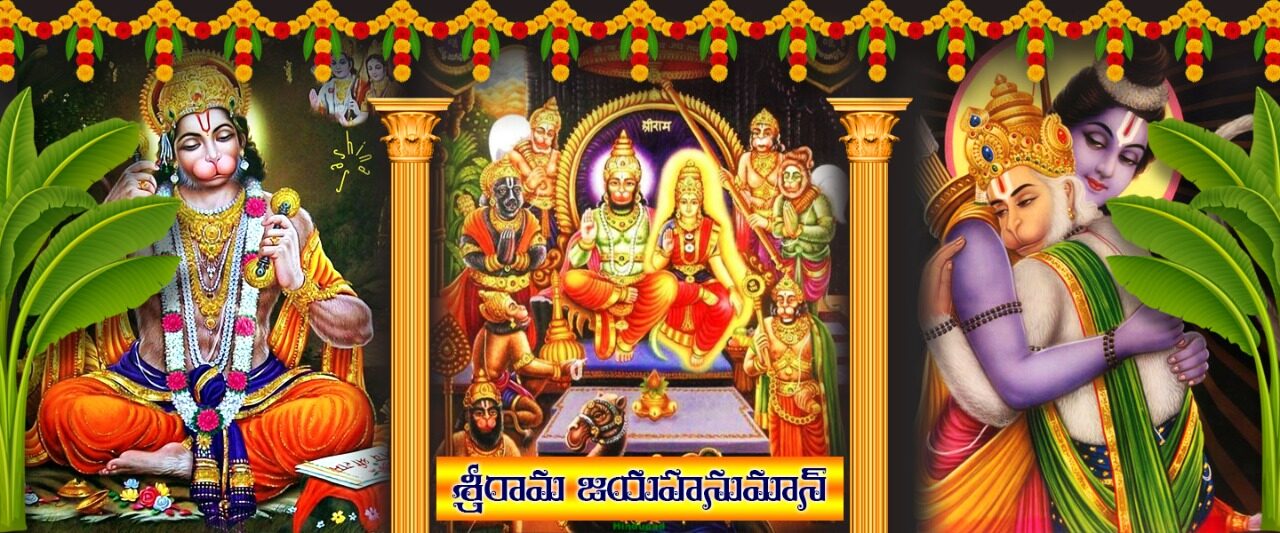

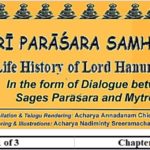
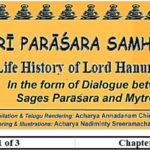


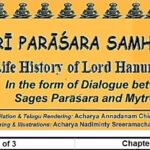
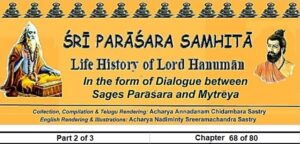
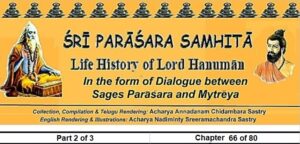
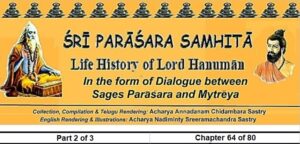
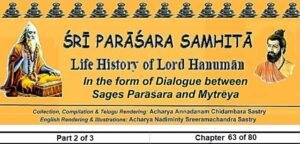
Be First to Comment